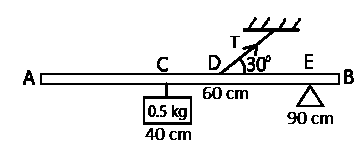
16.67N
15.67N
14.67N
18.67N
Correct answer is A
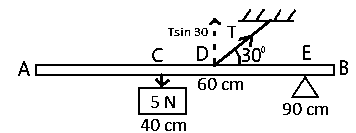
W = mg = 0.5 x 10 = 5 N
Since it's light, neglect the weight of the metre rule.
The effective tension T acting in the vertical direction = T sin 30°
From the second condition of equilibrium, sum of clockwise moments equal sum of anticlockwise moments
Taking moment at E
⇒ T sin 30° x 30 = 5 x 50
⇒ ∴T=250
T = \(\frac{250}{15}\) = 16.67N
the principle of the reversibility of light
the principle of the rectilinear propagation of light
Huygen’s principle
the principle of total internal reflection of light
Correct answer is B
The pinhole camera works on the principle of the rectilinear propagation of light. This principle states that light travels in straight lines. When light passes through the tiny hole in a pinhole camera, it forms an inverted image on the opposite side of the camera. The size of the image depends on the distance between the object and the pinhole
(i) and (iii) only
(i), (ii) and (iv) only
(i) and (iv) only
(ii) and (iii) only
Correct answer is D
The S.I unit of heat capacity is JK-1 and it is an extensive property as it depends on the amount of substance present.
Therefore, (i) and (iv) only are not true
2 diopters
2.5 diopters
0.5 diopters
3 diopters
Correct answer is A
The patient cannot see clearly an object closer than 50 cm
Therefore, the patient needs a lens that would enable him see clearly, objects placed 25 cm from the lens
So, we take the object to a distance of 25 cm from the lens so that the image forms at 50 cm in front of the lens
u=25cm ;v=-50cm (virtual image); p=
\(\frac{1}{f}\)=\(\frac{1}{u}\) + \(\frac{1}{v}\)
⇒\(\frac{1}{f}\) =\(\frac{1}{50}\)
⇒\(\frac{1}{f}\) = \(\frac{1}{25}\)-\(\frac{1}{50}\)
⇒\(\frac{1}{f}\) = f = 50cm =0.5m
⇒\(\frac{1}{f}\) = \(\frac{2-1}{50}\)
p = \(\frac{1}{f}\)
p = \(\frac{1}{0.5}\)
p = 2 diopters
; The patient needs a converging lens with a power of 2 diopters
A travelling wave of amplitude 0.80 m has a frequency of 16 Hz and a wave speed of 20 \(ms-1\)
Calculate the wave number of the wave.
3
42
5
2
Correct answer is C
A=0.8m; f=16Hz; v=20 \(ms^-1\); k=?
v = fλ
λ =1.25m
= k= \(\frac{2π}{λ}\) =\(\frac{2 × 3.142}{1.25}\)
k= 5m ( to 1 s.f)
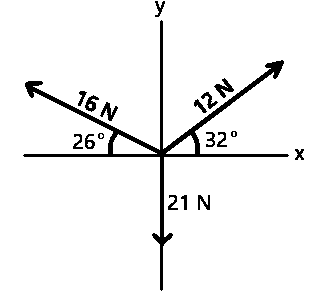
7.63N,61°
8.71N,61°
7.63N,29°
8.71N,29°
Correct answer is B
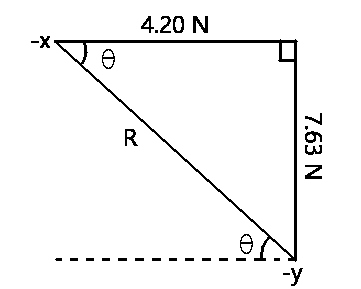
Fx= 12cos32°-16cos26° = -4.20N (right is taken +ve and left is taken -ve)
Fy=12sin32°+16sin26°-21 = -7.63N (up is taken +ve and down is taken -ve)
\(R^2\)= 4.202+7.632
⇒\(R^2\) = 75.86
⇒ R=√75.86
∴R = 8.71 N
tan θ=\(\frac{opp}{adj}\)
⇒tan θ=\(\frac{7.63}{4.20}\)
⇒tan θ =1.8095
⇒ θ = \(tan^-1\) (1.8095)
θ = 61°
∴The angle of the resultant force with the x-axis is 61°
5.23 m
6.42 m
4.87 m
7.26 m
Correct answer is A
Let the original length L=xm
;New length =( x -3 ) m
\(T_1\) = 5.77s; \(T_2\) = 4.60s,
\(T^2\) α L
⇒\(T_2) = kL where K is constant
⇒K = \(\frac{T^2_1}{L_1}\) = \(\frac{T^2_2}{L_2}\)
⇒\(\frac{5.77^2}{x}\) = \(\frac{4.60^2}{x-3}\)
⇒ \(\frac{33.29}{x}\) = \(\frac{4.60^2}{x-3}\)
⇒ 33.29(x-3) = 21.16x
⇒ 33.29x - 99.87 =21.16x
⇒12.13x = 99.87
;x =\(\frac{99.87}{12.13}\) = 8.23m
New length of the pendulum
=x-3 = 8.23-3
=5.23m
\(5.09×10^{15}\)Hz
\(5.09×10^{14}\) Hz
\(1.77×10^{15}\) Hz
\(1.77×10^{14}\) Hz
Correct answer is B
n=1.458, c=\(3.00 ×10^8 ms^-1\) ,λo = 589nm; f=?
Speed of light in a medium (v)=\(\frac{c}{n}\) where n is the refractive index of the medium
⇒λn=\(\frac{589}{1.458}\) = 404nm
v=fλ
⇒f=\(\frac{v}{λ}\)
=\(\frac{2.06×10^8}{404×10^-9}\) \(1nano=10^{-9}\)
∴f=\(5.09×10^{14}\) Hz
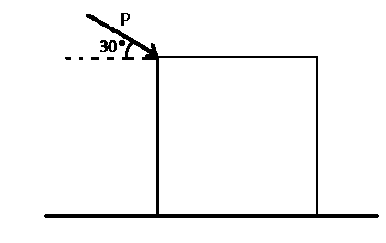
0.19
0.24
0.40
0.22
Correct answer is A
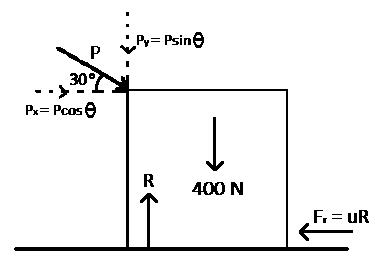
W = 400 N; P = 100 N; θ = 30o; μ = ?
Frictional force (Fr) = μR (where R is the normal reaction)
The forces acting along the horizontal direction are Fr and Px
∴ Pcos 30° - Fr = ma (Pcos 30° is acting in the +ve x-axis while Fr in the -ve x-axis)
⇒ 100cos 30° - μR = ma
Since the box is moving at constant speed, its acceleration is zero
⇒ 100cos 30° - μR = 0
⇒ 100cos 30o = μR ----- (i)
The forces acting in the vertical direction are W, Py and R
∴ R - Psin 30° - W = 0 (R is acting upward (+ve) while Py and W are acting downward (-ve) and they are at equilibrium)
⇒ R - 100sin 30° - 400 = 0
⇒ R = 100sin 30° + 400
⇒ R = 50 + 400 = 450 N
From equation (i)
⇒ 100cos 30° = 450μ
⇒μ=100cos30°
N = \(\frac{100cos30°}{450}\)
= μ = 0.19
JAMB Subjects
Aptitude Tests
Latest Jobs
Information and Communication Manager at Nigerian Breweries Plc
Area Sales Manager at Airtel Nigeria
State Business Manager at Airtel Nigeria
Regional Technical Officer at Airtel Nigeria
Business Manager at Airtel Nigeria
Contract Administrator at Robert Walters
Import & Export Manager at Kerildbert Holdings Limited
JV Account Payable Officer at WTS Energy
HR Intern, Learning and Development at MainOne Cable
Senior Technical Officer - Endemic Diseases & NTDs (AfCDC) at the African Union